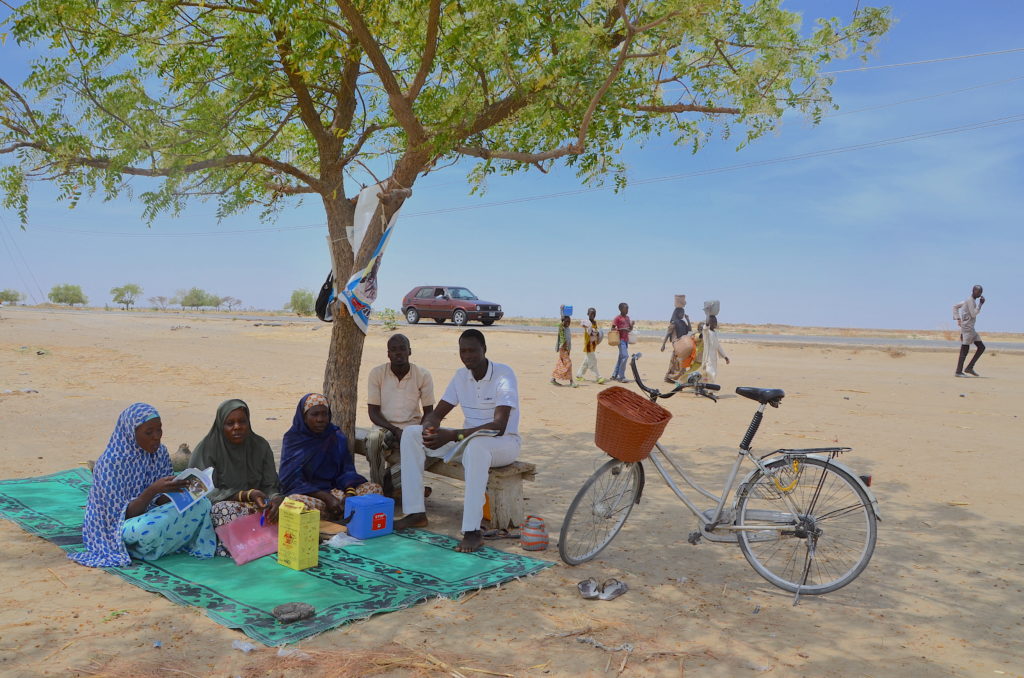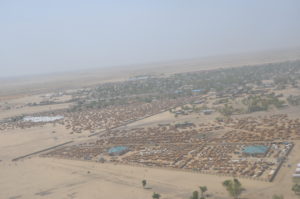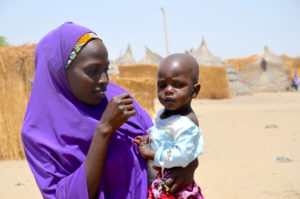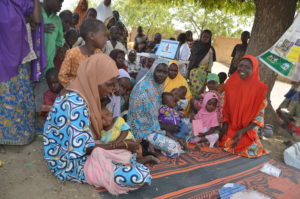Monguno: Can Polio’s Furthest Outpost be its Final Frontier?
In a remote corner of northern Nigeria, 95% of children are being reached with the polio vaccine.

In north-eastern Nigeria, Monguno is literally at the end of the line. To get there, you have to fly by helicopter from Maiduguri, capital of the embattled state of Borno, across 100 kilometres of Boko Haram-controlled territory to this piercingly hot and dusty safe haven of a city.
Three roads enter Monguno, from the west, north and south. On each entrance, there are three successive military checkpoints. Here, hundreds of people fleeing famine or insurgents arrive each day, in cars, on trucks or by foot, to seek food, safety and healthcare in Monguno’s sprawling camps for Internally Displaced Persons (IDPs). As families leave their cars to be searched, polio transit teams wait to vaccinate any child under 10 with two precious drops of polio vaccine.
Polio amidst conflict

In August last year, Africa was on the verge of celebrating two years without any cases of polio when large-scale military action across Borno resulted in 1.6 million people fleeing for safety. Hundreds of thousands poured into Monguno, and shockingly, two of the children who arrived with their parents had been paralyzed by polio. Another child arrived in Gwoze, in the State’s south-east, while a fourth was detected in the capital. Nigeria wasn’t polio-free as hoped – the virus had survived somewhere in inaccessible areas of the country.
A large-scale emergency outbreak response was launched to rapidly raise immunity to the wild poliovirus and guard against further spread, repeatedly vaccinating 41 million children across the Lake Chad region, encompassing northern Nigeria, Niger, Chad, Cameroon and the Central African Republic. The polio vaccine was offered to vulnerable families together with a range of desperately needed health services, including screening for severe acute malnutrition, distribution of vitamin A and zinc, and the delivery of bed nets to protect against malaria.
Stopping the virus

In March, 192,800 vaccinators in 13 countries across west and central Africa targeted a staggering 116 million children in synchronized campaigns to build a wall of immunity against the virus. This World Immunization Week, more than 74,300,000 children will once again be immunized across the five countries bordering Lake Chad.
The scale of the response reveals why the transit teams at Monguno’s outer limits are some of the most important polio workers on the planet. Not only could the children arriving in this city be carrying the poliovirus but the youngest have never received vaccination against it. Stop the virus in these inaccessible areas of Borno, and it is possible that all of Africa will be polio-free.
These transit teams are made up of a health worker, providing the injectable Inactivated Polio Vaccine and measles vaccines, an oral polio vaccine vaccinator, two recorders, and a person whose job it is to gather the parents and young children as they pass.
Vaccinating every child
The families pass each day in their hundreds. Muhammad Dupime, WHO’s Monguno Cluster Coordinator, says the official population of Monguno is over 700,000 but “so many people have come from outside the city that it is many, many more”. For proof, the number of children under five years of age immunized in monthly house-to-house, or more accurately, tent-to-tent campaigns rises by an average of 11,000 children a month.
To respond to the growing numbers, more vaccination teams are hired and trained to ensure every last newly-arrived child is reached in campaigns. New arrivals are tracked and prioritized to ensure they rapidly receive the required doses to be protected against the virus. Teams visit homes, markets, schools and playgrounds. And it’s working – external monitoring found in March that more than 95% of children were vaccinated – even in the furthest flung corners of the 13 sprawling IDP camps.

Health Beyond Polio
Inside Monguno, polio “health camps” aim to provide broader healthcare services to hard-to-reach populations. Abubakar Gambo, the local government area Facilitator for Gana Ali, arranges 12 health camps a month. “Some understand what we are providing but many IDPs have never seen health care,” Mr Gambo says. “We have to explain about the vaccinations, about how they protect children.”
UNICEF-supported social mobilizers work between campaigns to educate mothers about the importance of vaccinations, hand washing messages and how to prevent and treat diarrheal episodes. They track pregnant mothers in order to facilitate ante-natal care and ensure newborns are registered into the routine immunization system.
These heroes who go house-to-house, tent-to-tent, to markets, schools and playgrounds, who immunize children at transit points and in health camps, are the keys to the success of the eradication effort. Monguno may be one of polio’s furthest outposts, but the commitment and determination of its polio workers may see this sprawling tent city be polio’s final resting place in all of Africa.












